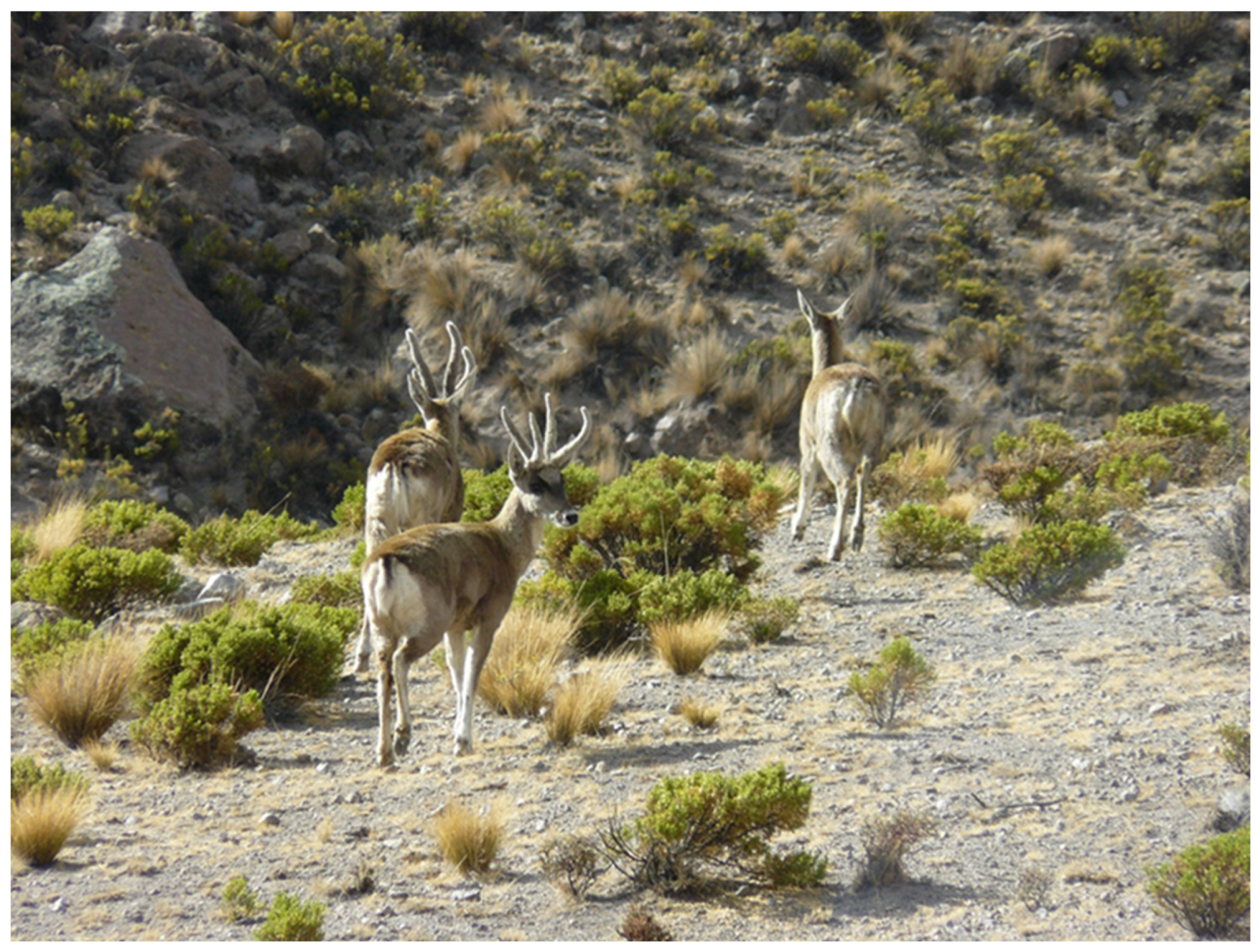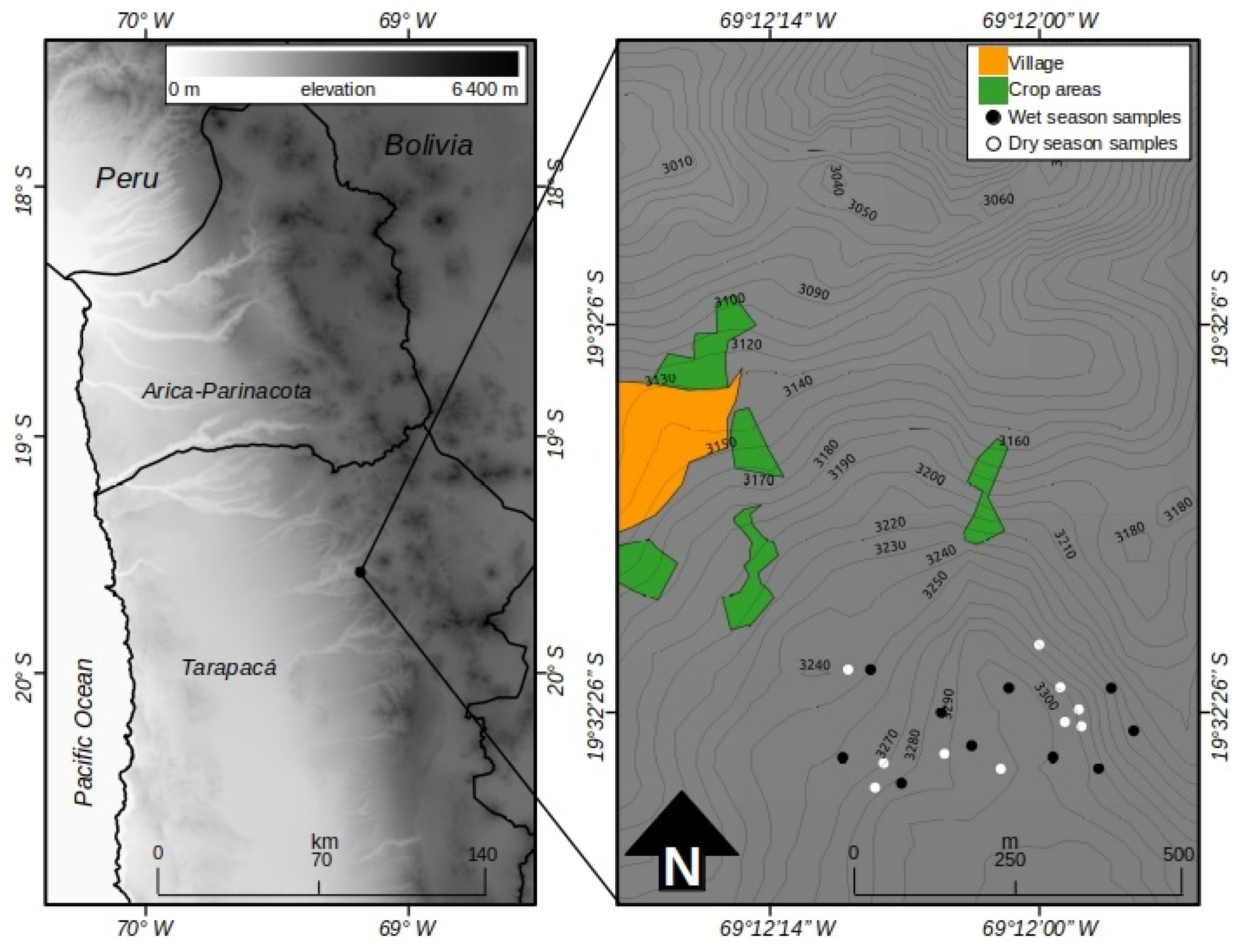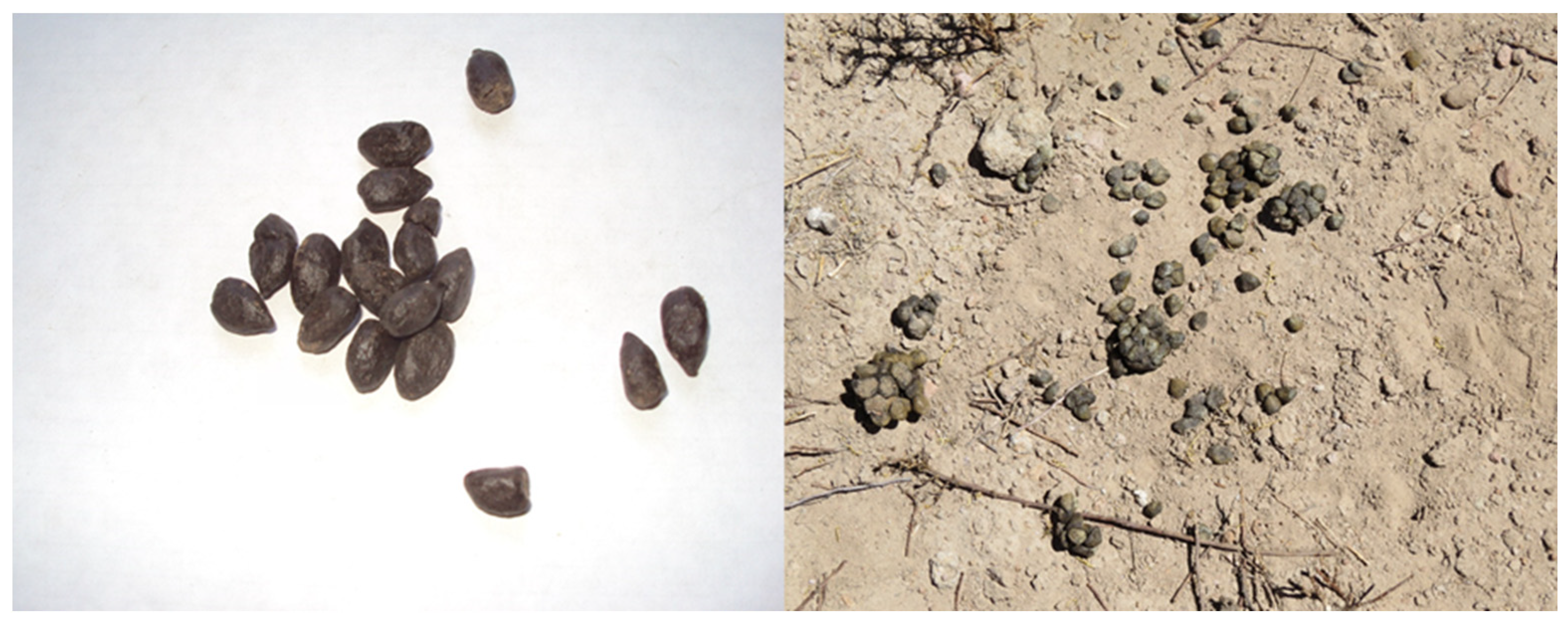Preliminary Report on Diet Estimation of Taruka (Hippocamelus antisensis d’Orbigny, 1834) in an Agricultural Area of the Andean Foothills of the Tarapacá Region, Chile
Abstract
Simple Summary
Abstract
1. Introduction
2. Materials and Methods
2.1. Study Area
2.2. Botanical Composition and Rangeland Cover
2.3. Collection of Fecal Samples and Determination of the Botanical Composition of the Diet
2.4. Diet Diversity
2.5. Fecal Nitrogen
2.6. Statistical Analysis
3. Results
3.1. Botanical Composition and Range Plant Cover
3.2. Diet’s Botanical Composition
3.3. Diet’s Diversity
3.4. Fecal Nitrogen
4. Discussion
4.1. Botanical Composition and Range Plant Cover
4.2. Diet Botanical Composition
4.3. Diet’s Diversity
4.4. Fecal Nitrogen
5. Conclusions
Author Contributions
Funding
Institutional Review Board Statement
Informed Consent Statement
Data Availability Statement
Acknowledgments
Conflicts of Interest
References
- Holechek, J.L.; Pieper, R.D.; Herbel, C.H. Range Management, Principles and Practices, 6th ed.; Prentice Hall: Upper Saddle River, NJ, USA, 2011; p. 444. [Google Scholar]
- Ballari, S.A.; Cuevas, M.F.; Ojeda, R.A.; Navarro, J.L. Diet of wild boar (Sus scrofa) in a protected area of Argentina: The importance of baiting. Mamm Res. 2015, 60, 81–87. [Google Scholar] [CrossRef]
- Pelliza Sbriller, A.; Borrelli, Y.L.; Sepúlveda, L. ¿Qué Comen los herbívoros? Desde La Patagon. Difundiendo Saberes A 2004, 1, 2–7. Available online: https://revele.uncoma.edu.ar/index.php/desdelapatagonia/article/view/4229/61196 (accessed on 12 November 2023).
- Hanley, T. The Nutritional Basis for Food Selection by Ungulates. J. Range Manag. 1982, 35, 146–151. [Google Scholar] [CrossRef]
- Dryden, G.M. Animal Nutrition Science; CABI: Oxfordshire, UK, 2008; p. 415. [Google Scholar]
- Leslie, D.; Starkey, E. Fecal indices to dietary quality of cervids in old–growth forests. J. Wild. Manag. 1985, 49, 142–146. [Google Scholar] [CrossRef]
- Osborn, R.; Ginnett, T. Fecal Nitrogen and 2, 6-Diaminopimelic Acids as Indices to Dietary Nitrogen in White-Tailed Deer. Wildl. Soc. Bull. 2001, 29, 1131–1139. [Google Scholar]
- Kamler, J.; Homolka, M. Faecal nitrogen: A potential indicator of red and roe deer diet quality in forest habitat. Folia. Zool. 2005, 54, 89–98. [Google Scholar]
- Monteith, K.B.; Monteith, K.L.; Bowyer, R.T.; Leslie, D.M., Jr.; Jenks, J.A. Reproductive effects on fecal nitrogen as an index of diet quality: An experimental assessment. J. Mammal. 2014, 95, 301–310. [Google Scholar] [CrossRef]
- Orellana, C.; Parraguez, V.H.; Arana, W.; Escanilla, J.; Zavaleta, M.; Castellaro, G. Use of Fecal Indices as a Non–Invasive Tool for Nutritional Evaluation in Extensive–Grazing Sheep. Animals 2020, 10, 46. [Google Scholar] [CrossRef] [PubMed]
- Orellana, C.; Castellaro, G.; Escanilla, J.; Parraguez, V.H. Use of Fecal Indices as a Non-Invasive Tool for Ruminal Activity Evaluation in Extensive Grazing Sheep. Animals 2022, 12, 974. [Google Scholar] [CrossRef]
- Barrio, J. TARUKA Hippocamelus antisensis (d’Orbigny 1834). In Neotropical Cervidology. Biology and Medicine of Latin American Deer; Duarte, J.B.M., González, S., Eds.; Chapter 9; FUNEP, Jaboticaba, Brazil and IUCN: Gland, Switzerland, 2010; pp. 77–88. [Google Scholar]
- Barrio, J. Hippocamelus antisensis (Artiodactyla: Cervidae). Mamm. Species 2013, 45, 49–59. [Google Scholar] [CrossRef][Green Version]
- Barrio, J.; Nuñez, A.; Pacheco, L.; Regidor, H.A.; Fuentes-Allende, N. Hippocamelus antisensis. The IUCN Red List of Threatened Species, e.T10053A22158621. 2017. Available online: http://dx.doi.org/10.2305/IUCN.UK.2017-2.RLTS.T10053A22158621.en (accessed on 13 May 2024).
- CITES. 2023. Appendices I, II and III. Available online: https://cites.org/eng/app/appendices.php (accessed on 13 May 2024).
- Fuentes-Allende, N.; Vielma, A.; Paulsen, K.; Arredondo, C.; Corti, P.; Estades, C.F.; González, B.A. Is human disturbance causing differential preference of agricultural landscapes by taruka and feral donkeys in high Andean deserts during the dry season? J. Arid. Environ. 2016, 135, 115–119. [Google Scholar] [CrossRef]
- Mata, C.; Fuentes-Allende, N.; Malo, J.; Vielma, A.; González, B. The mismatch between location of protected areas and suitable habitat for the Vulnerable taruka Hippocamelus antisensis. Oryx 2019, 53, 752–756. [Google Scholar] [CrossRef]
- Muñoz, A.E.; Petitpas, R.; Marín, J.C.; Bonacic, C. A conflict between a threatened deer and indigenous agriculture: Tarukas (Hippocamelus antisensis D’Orbigny) and Aymara farmers in northern Chile. Gayana 2021, 85, 35–45. [Google Scholar] [CrossRef]
- Sielfeld, W.; Carrasco, C.; González, G.; Torres, J. La Taruca (Hippocamelus antisensis d‘Orbigny, 1834, Cervidae, Artiodactyla) en la Provincia de Parinacota, Región de Tarapacá, Chile: Población hábitat & alimentación. An. Mus. Hist. Nat. Valparaíso 1999, 24, 95–108. [Google Scholar]
- Zúñiga, E. Incidencia del Estado Fisiológico Sobre la Conducta Alimenticia de la Taruca (Hippocamelus antisensis d’Orbigny 1834) en sector Chapiquiña, Parque Nacional Lauca; Departamento de Biología, Facultad de Ciencias, Universidad de Tarapacá: Arica, Chile, 2011; 53p. [Google Scholar]
- Gazzolo, C.; Barrio, J. Feeding Ecology of Taruca (Hippocamelus antisensis) Populations during the Rainy and Dry Seasons in Central Peru. Int. J. Zool. 2016, 5806472. [Google Scholar] [CrossRef]
- Köeppen, W. Climatología. Fondo de Cultura Económica; Carretera Picacho-Ajusco: Ajusco, México, 1948; p. 478. [Google Scholar]
- United States Department of Agriculture (USDA). Keys to Soil Taxonomy, 10th ed.; Department of Agriculture, Soil Survey Staff. Natural Resource Conservation Service: Washington, DC, USA, 2006; p. 333.
- Luebert, F.; Piscloff, P. Sinopsis bioclimática y Vegetacional de Chile, 2nd ed.; Editorial Universitaria: Santiago, Chile, 2018; ISBN 9789561125759. 384p. [Google Scholar]
- Goykovic, J. Productive agricultural systems in the desert macro-region of Chile. IDESIA 2012, 30, 3–10. [Google Scholar] [CrossRef][Green Version]
- Bonham, C.D. Measurements for Terrestrial Vegetation; J. Wiley & Sons: Hoboken, NJ, USA, 1989; 338p. [Google Scholar]
- Sparks, D.R.; Malechek, J.C. Estimating percentage dry weight in diets using a microscope technique. J. Range Manag. 1968, 21, 264–265. [Google Scholar] [CrossRef]
- Holechek, J.L.; Gross, B. Evaluation of different calculation procedures for microhistological analysis. J. Range Manag. 1982, 35, 721–726. [Google Scholar] [CrossRef]
- Garnick, S.; Barboza, P.S.; Walker, J.W. Assessment of Animal-Based Methods Used for Estimating and Monitoring Rangeland Herbivore Diet Composition. Rangel. Ecol. Manag. 2018, 71, 449–457. [Google Scholar] [CrossRef]
- Ortega, I.M.; Berger, M.I.; Flores, M. Manual de Técnica Microhistológica; IBTA 113/Textos y Manuales 04/Rumiantes Menores (SR-CRSP) 05/1993; IBTA: La Paz, Bolivia, 1993; 48p. [Google Scholar]
- Castellaro, G.; Squella, F.; Ullrich, T.; León, F.; Raggi, L. Algunas técnicas microhistológicas utilizadas en la determinación de la composición botánica de la dieta de herbívoros. Agric. Técnica Chile 2007, 67, 86–93. [Google Scholar]
- Catán, A.; Degano, A.M.; Larcher, L. Modificaciones a la Técnica Microhistológica de Peña-Neira Para Especies Forrajeras del Chaco Argentino; Quebracho. Revista de Ciencias Forestales. Diciembre Nº 010; Universidad Nacional de Santiago del Estero: Santiago del Estero, Argentina, 2003; pp. 71–75. [Google Scholar]
- Krebs, C.J. Ecología. In Estudio de la Distribución y la Abundancia, 2nd ed.; Harla: Mexico D.F., México, 1989; 753p. [Google Scholar]
- Smith, R.L.; Smith, T.M. Elements of Ecology, 8th ed.; Pearson: Boston, MA, USA, 2012; 704p. [Google Scholar]
- A.O.A.C. Official Methods of Analysis of the AOAC International, 17th ed.; Association of Official Analytical Chemist. Ed.: Arlington, TX, USA, 2000. [Google Scholar]
- Kaps, M.; Lamberson, Y.W. Biostatistics for Animal Science; CABI Publishing: Oxfordshire, UK, 2004; 445p. [Google Scholar]
- Escobar, J.M. Los Pastizales Naturales de la Patagonia; INTA Estación Experimental Agropecuaria Chubut: Trelew, Argentina, 2008; 83p. [Google Scholar]
- Stuth, J.W. Foraging behavior. Chapter 3, pp. 65–83. In Grazing Management. An Ecological Perspective; Heitschmidt, R.K., Stuth, J.W., Eds.; Timber Press: Portland, OR, USA, 1991; 259p. [Google Scholar]
- Granda, A.; Bartoli, A.; Tortosa, R.D. Una variedad de Grindelia tarapacana (Asteraceae, Astereae) de Perú. Bol. Soc. Argent. Bot. 2000, 35, 157–159. [Google Scholar]
- Pistelli, L. Secondary metabolites of genus astragalus: Structure and biological activity. In Studies in Natural Products Chemistry; Atta-ur-Rahman, Ed.; Elsevier Science B.V: Amsterdam, The Netherlands, 2002; Volume 27. [Google Scholar]
- Yang, L.P.; Shen, J.G.; Xu, W.C.; Li, J.; Jiang, J.Q. Secondary Metabolites of the Genus Astragalus: Structure and Biological-Activity Update. Chem. Biodivers. 2013, 10, 1004–1054. [Google Scholar] [CrossRef] [PubMed]
- Robles, C.A.; Saber, C.; Jefrey, M. Intoxicación por Astragalus pehuenches (locoismo) en ovinos Merino de la Patagonia Argentina. Rev. Med. Vet. 2000, 81, 380–384. [Google Scholar]
- Hofmann, R.R. Evolutionary steps of ecophysiological adaptation and diversification of ruminants: A comparative view of their digestive system. Oecologia 1989, 78, 443–457. [Google Scholar] [CrossRef] [PubMed]
- Cheeke, P.R.; Dierendfeld, E.S. Comparative Animal Nutrition and Metabolism; CABI: Carson, CA, USA, 2010; 339p. [Google Scholar]
- Takatsuki, S.; Tsuji, Y.; Widayati, K.A.; Suryobroto, B. Seasonal changes in the dietary compositions of rusa deer in Pangandaran Nature Reserve, West Java, Indonesia. Austral Ecol. 2023, 48, 1056–1063. [Google Scholar] [CrossRef]
- Figueroa, R.A.; Corales, E.S. Hábitat y dieta del huemul (Hippocamelus bisulcus) en el Corredor Biológico Nevados de Chillán-Laguna Laja: La importancia de la flora andina para la conservación de un cérvido en peligro de extinción. Rev. Chagual 2007, 5, 21–32. [Google Scholar]
- Galende, G.; Ramilo, E.; Beati, A. Diet of Huemul deer (Hippocamelus bisulcus) in Nahuel Huapi National Park, Argentina. Stud. Neotrop. Fauna Environ. 2005, 40, 1–5. [Google Scholar] [CrossRef]
- Vila, A.R.; Borrelli, L.; Aprile, G. Dieta de fines de verano del huemul, Hippocamelus bisulcus, en el valle del río de Las Vueltas, Argentina. An. Inst. Patagon. (Chile) 2011, 39, 113–117. [Google Scholar] [CrossRef]
- Castellaro, G.; Orellana, C.L.; Escanilla, J.P.; Bastías, C.; Cerpa, P.; Raggi, L. Botanical Composition and Diet Quality of the Vicuñas (Vicugna vicugna Mol.) in Highland Range of Parinacota, Chile. Animals 2020, 10, 1205. [Google Scholar] [CrossRef]
- Castellaro, G.; Orellana, C.L.; Escanilla, J.P. Summer Diet of Horses (Equus ferus caballus Linn.), Guanacos (Lama guanicoe Müller), and European Brown Hares (Lepus europaeus Pallas) in the High Andean Range of the CoquimboRegion, Chile. Animals 2021, 11, 1313. [Google Scholar] [CrossRef]
- Vila, A.R.; Borrelli, L.; Martínez, L. Dietary Overlap Between Huemul and Livestock in Los Alerces National Park, Argentina. J. Wildl. Manag. 2009, 73, 368–373. [Google Scholar] [CrossRef]
- Kie, J.G.; Burton, T.S. Dietary Quality, Fecal Nitrogen and 2,6 Diaminopimelic Acid in Black-Tailed Deer in Nortern California; United States Department of Agriculture; Forest Service; Pacific Southwest Forest and Range Experiment Station: Berkeley, CA, USA, 1984; 4p. [Google Scholar]
- Čupić, S.; García, A.J.; Holá, M.; Ceacero, F. Evaluation of factors inducing variability of faecal nutrients in captive red deer under variable demands. Sci. Rep. 2021, 11, 2394. [Google Scholar] [CrossRef] [PubMed]
- Hodgman, T.P.; Davitt, B.B.; Nelson, J.R. Monitoring mule deer diet quality and intake with fecal indices. J. Range Manag. 1996, 49, 215–222. [Google Scholar] [CrossRef]
- National Research Council (NRC). Nutrient Requirements of Small Ruminants: Sheep, Goats, Cervids, and New World Camelids; The National Academic Press: Washington, DC, USA, 2007; p. 362. [Google Scholar]
- Pierce, R., II; Vandeloecht, A.B.; Flinn, E. Nutritional Requirements of White-Tailed Deer in Missouri; G9487; University of Missouri Extension: Columbia, CA, USA, 2015; Available online: http://extension.missouri.edu/p/g9487 (accessed on 13 January 2024).




| Vegetal Species | Season | |
|---|---|---|
| Wet Season (%) | Dry Season (%) | |
| Ambrosia artemisiodes | 64.0 ± 46.0 | 75.4 ± 38.5 |
| Grindelia tarapacana | 17.8 ± 28.1 | 19.5 ± 37.5 |
| Baccharis boliviensis | 12.2 ± 19.6 | 1.0 ± 2.6 |
| Astragalus sp. | 0.8 ± 2.0 | 0.0 |
| Balbisia microphylla | 0.7 ± 1.8 | 2.8 ± 6.8 |
| Cumulopuntia sphaerica | 0.7 ± 1.6 | 0.0 |
| Fabiana ramulosa | 1.7 ± 4.1 | 0.0 |
| Stipa sp. | 0.8 ± 2.0 | 0.0 |
| Tagetes multiflora | 1.3 ± 3.1 | 1.3 ± 2.3 |
| Total | 100.0 | 100.0 |
| Plant cover | 25.3 ± 6.5 | 26.3 ± 10.2 |
| Bare soil | 23.7± 5.9 | 24.6 ± 9.7 |
| Stones | 10.2 ± 6.9 | 11.8 ± 14.8 |
| Rocks | 28.4 ± 8.0 | 23.3 ± 8.7 |
| Litter | 12.5 ± 7.3 | 13.9 ± 9.1 |
| Relative diversity (%) | 43.0 ± 28.4 | 31.2 ± 32.2 |
| Plant Species | Wet Season | Dry Season | p-Value 1 |
|---|---|---|---|
| Mean ± SD | Mean ± SD | ||
| Forage species | |||
| Medicago sativa | 27.6 ± 8.2 | 53.9 ± 9.2 | <0.001 |
| Horticultural crop species | 1.3 ± 1.3 | 0.0 ± 0.0 | |
| Allium sativum | 0.1 ± 0.2 | 0.0 ± 0.0 | |
| Zea mays | 0.3 ± 0.9 | 0.0 ± 0.0 | |
| Origanum vulgare | 0.9 ± 1.1 | 0.0 ± 0.0 | |
| Cucurbita moschata | 0.1 ± 0.4 | 0.0 ± 0.0 | |
| Grasses | 2.5 ± 2.2 | 3.2 ± 1.5 | 0.4317 |
| Cortaderia jubata | 0.0 ± 0.0 | 0.0 ± 0.0 | |
| Bromus catharticus | 0.1 ± 0.2 | 0.0 ± 0.0 | |
| Stipa sp. | 0.7 ± 0.8 | 0.1 ± 0.1 | |
| Polypogon australis | 0.7 ± 1.0 | 3.1 ± 1.4 | |
| Poa sp. | 0.0 ± 0.0 | 0.0 ± 0.0 | |
| Stipa leptostachya | 0.2 ± 0.8 | 0.0 ± 0.0 | |
| Muhlenbergia asperifolia | 0.2 ± 0.8 | 0.0 ± 0.0 | |
| Stipa mucronata | 0.6 ± 1.1 | 0.0 ± 0.1 | |
| Graminoids | 0.7 ± 1.0 | 0.1 ± 0.1 | 0.0453 |
| Isolepis cernua | 0.0 ± 0.1 | 0.0 ± 0.0 | |
| Scirpus asper | 0.7 ± 1.0 | 0.1 ± 0.1 | |
| Dicotyledonous herbs | 46.3 ± 9.5 | 19.4 ± 8.7 | <0.001 |
| Convolvulus arvensis | 1.9 ± 1.7 | 0.0 ± 0.0 | |
| Schinus molle | 0.1 ± 0.2 | 0.0 ± 0.0 | |
| Erodium sp. | 5.3 ± 6.8 | 0.0 ± 0.0 | |
| Tagetes multiflora | 1.5 ± 3.0 | 0.2 ± 0.4 | |
| Astragalus sp. | 21.0 ± 8.5 | 15.7 ± 9.2 | 0.1758 |
| Pellaea ternifolia | 6.6 ± 8.3 | 0.1 ± 0.2 | |
| Bidens andicola | 0.2 ± 0.4 | 0.2 ± 0.4 | |
| Lupinus tarapacensis | 0.2 ± 0.3 | 1.1 ± 0.8 | |
| Otholobium pubescens | 0.4 ± 1.1 | 0.0 ± 0.0 | |
| Spergularia fasciculata | 1.3 ± 0.9 | 0.0 ± 0.0 | |
| Aldama helianthoides | 2.3 ± 4.8 | 0.3 ± 0.4 | |
| Malva parviflora | 2.0 ± 3.0 | 0.0 ± 0.0 | |
| Aldama sp. | 1.3 ± 2.0 | 0.0 ± 0.0 | |
| Marrubium vulgare | 0.0 ± 0.0 | 0.0 ± 0.0 | |
| Althaea rosea | 2.3 ± 2.3 | 0.0 ± 0.1 | |
| Matricaria recutita | 0.1 ± 0.2 | 0.0 ± 0.0 | |
| Montiopsis sp. | 0.0 ± 0.0 | 1.8 ± 2.1 | |
| Shrubs | 21.5 ± 7.8 | 23.4 ± 7.0 | 0.5553 |
| Atriplex glaucescens | 0.2 ± 0.8 | 0.0 ± 0.0 | |
| Balbisia microphylla | 0.2 ± 0.4 | 0.6 ± 0.8 | |
| Fabiana ramulosa | 0.1 ± 0.3 | 0.0 ± 0.1 | |
| Baccharis boliviensis | 3.9 ± 2.9 | 8.2 ± 6.2 | 0.0599 |
| Grindelia tarapacana | 1.1 ± 1.3 | 0.1 ± 0.2 | |
| Senna birostris var. Arequipensis | 0.7 ± 1.6 | 0.1 ± 0.3 | |
| Ambrosia artemisiodes | 1.1 ± 1.6 | 0.1 ± 0.4 | |
| Tarasa operculata | 4.9 ± 4.4 | 1.1 ± 1.1 | 0.0086 |
| Senecio coscayamus | 3.0 ± 2.0 | 0.4 ± 0.6 | |
| Krameria lappacea | 3.2 ± 5.0 | 8.7 ± 4.9 | 0.0167 |
| Escallonia angustifolia | 0.1 ± 0.3 | 0.2 ± 0.4 | |
| Junellia arequipensis | 0.7 ± 1.0 | 0.0 ± 0.0 | |
| Aphyllocladus denticulatus | 0.0 ± 0.1 | 0.0 ± 0.0 | |
| Baccharis juncea | 1.4 ± 4.5 | 0.0 ± 0.0 | |
| Ephedra breana | 0.8 ± 2.4 | 3.8 ± 3.5 |
Disclaimer/Publisher’s Note: The statements, opinions and data contained in all publications are solely those of the individual author(s) and contributor(s) and not of MDPI and/or the editor(s). MDPI and/or the editor(s) disclaim responsibility for any injury to people or property resulting from any ideas, methods, instructions or products referred to in the content. |
© 2024 by the authors. Licensee MDPI, Basel, Switzerland. This article is an open access article distributed under the terms and conditions of the Creative Commons Attribution (CC BY) license (https://creativecommons.org/licenses/by/4.0/).
Share and Cite
Castellaro, G.L.; Orellana, C.L.; Escanilla, J.P.; Fuentes-Allende, N.; González, B.A. Preliminary Report on Diet Estimation of Taruka (Hippocamelus antisensis d’Orbigny, 1834) in an Agricultural Area of the Andean Foothills of the Tarapacá Region, Chile. Animals 2024, 14, 1814. https://doi.org/10.3390/ani14121814
Castellaro GL, Orellana CL, Escanilla JP, Fuentes-Allende N, González BA. Preliminary Report on Diet Estimation of Taruka (Hippocamelus antisensis d’Orbigny, 1834) in an Agricultural Area of the Andean Foothills of the Tarapacá Region, Chile. Animals. 2024; 14(12):1814. https://doi.org/10.3390/ani14121814
Chicago/Turabian StyleCastellaro, Giorgio Luis, Carla Loreto Orellana, Juan Pablo Escanilla, Nicolás Fuentes-Allende, and Benito A. González. 2024. "Preliminary Report on Diet Estimation of Taruka (Hippocamelus antisensis d’Orbigny, 1834) in an Agricultural Area of the Andean Foothills of the Tarapacá Region, Chile" Animals 14, no. 12: 1814. https://doi.org/10.3390/ani14121814
APA StyleCastellaro, G. L., Orellana, C. L., Escanilla, J. P., Fuentes-Allende, N., & González, B. A. (2024). Preliminary Report on Diet Estimation of Taruka (Hippocamelus antisensis d’Orbigny, 1834) in an Agricultural Area of the Andean Foothills of the Tarapacá Region, Chile. Animals, 14(12), 1814. https://doi.org/10.3390/ani14121814







